Was This Hidden Closet Part of the Underground Railroad in Brooklyn?
Get an exclusive look inside the Lott House, one of the oldest buildings in Brooklyn!


Jackson Heights began as a white middle-class neighborhood designed as a garden oasis and escape from the growing metropolis in Manhattan. However, the original Jackson Heights families eventually found greener grass in the suburbs, leaving empty apartments for sale. When President Lyndon B. Johnson passed the Immigration and Nationality Act of 1965, which lifted immigration quotas, many immigrants chose to settle in Jackson Heights. Now, this neighborhood is one of the most diverse in the city whose residents speak upward of 167 languages.
Diversity Plaza, a center for community in Jackson Heights, is the origin from which all life extends in the neighborhood. Various storefronts and restaurants surround the plaza, which contains seating for locals to gather for meals or conversations. Mayor Bill de Blasio considers Diversity Plaza to be an “epicenter of culture, community, and vibrancy” in Queens. He was right, for ethnic enclaves including Little India, Little Tibet, and Little Colombia are a short walk away.
Many of the ethnic communities within the neighborhood host at least one eatery selling specialties from their home country. Whether craving Nepalese fare, Colombian classics, or Indian specialties, Jackson Heights offers more than 25 cuisines sandwiched within the 300 acres of the neighborhood. This guide sorts through all the hidden gems, well-known restaurants, and hole-in-the-wall joints for the best food in Jackson Heights, Queens.

Steps from the Jackson Heights-Roosevelt Avenue subway station is Tibetan eatery Khampa Kitchen. Mr. Bachan and Ms. Dechen, founders of this New York Times Critic’s Pick eatery, cook recipes preserved by their families for generations. Bachan’s family, natives of the Kham region of Tibet, even sends packages of dried herbs they collect to Khampa Kitchen. Dishes such as Lhasa Noodles, a simple beef noodle soup, and fried beef ribs harbor strong traditional Tibetan flavors.
The dish Khampa Poethek harnesses the strong flavors of these herbs. The dish, a meat pie filled with beef and accented by chives, is typically served in a Tibetan home during a celebration. Chef Dechen crimps the edges of the dish to create a braidlike pattern. Although Dechen and her husband cannot currently share this meal during celebrations with relatives in Tibet, her meticulous handiwork is almost a way of sharing it with diners. The 30-minute wait for the dish allows for diners to try other Tibetan dishes in the meantime.

Momos originated in the Katmandu Valley in Nepal where the Newari people still live today. The Newari people typically steamed these dumplings and filled them with yak meat. However, in the United States, momos are typically filled with beef or vegetables. Whereas some restaurants serve momos in a round shape, others choose to serve their creations as a crescent.
In Jackson Heights, multiple food trucks, along with about a dozen restaurants, sell this Nepalese specialty. Amdo Kitchen, a food truck run by Thubten Amchok, sells momos by the fives for $8. Amchok is a former monk who has been selling momos for nine years. He fills his momos with ground beef, scallions, salt, and soy sauce surrounded by sheer skin. Potala Fresh Momo, another food truck in Jackson Heights, sells momos with a thicker skin than those of Amdo Kitchen. Customers can dip beef, vegetable, or chicken momos in a chili sauce dominated by red chili.
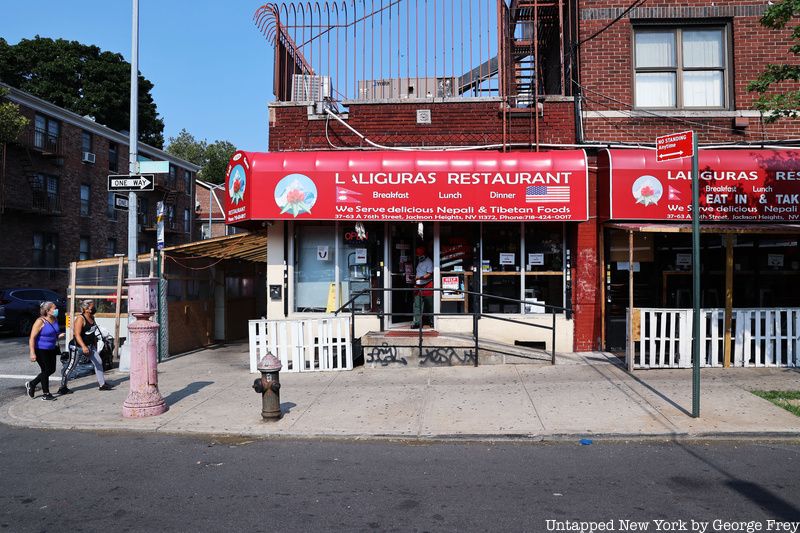
When in Jackson Heights and craving thali — a large meal served on a platter comprised of protein or vegetables, rice, and other sides — one should beeline towards Laliguras. A short walk from the Jackson Heights-Roosevelt Avenue subway station, this Nepalese and Tibetan eatery is under the radar despite quality dishes and affordable prices.
If you can only try one thing on the menu, feast on the goat thali. At Laliguras, the thali sides consist of lentil soup, a varying pickled vegetable dish, chutney, and dal, or dried pulses. Waiters refill rice and side dishes for no additional charge, making the meal a bargain. For those who have more room in their stomachs, the beef momo, tingmo, and thenthuk are must-tries.

Mustang Thakali Kitchen honors flavors of the Mustang region in Nepal that, according to CNN, was isolated from the world until 1991 when limited travelers were allowed within the region. What exists within this dry mountainous region today is a preserved Tibetan Buddhist culture and many natives traveling on horseback. Some young members of society leave the region because few Mustang natives live past 60 and most live in poverty. Granted this history of isolation, however, the Mustang community is small both outside of the Mustang region and within Jackson Heights.
Tibetan culture dominates the Mustang region despite the country it resides in. As a result, Mustang Thakali Kitchen is committed to serving dishes traditionally found in both Tibet and Nepal. Here is yet another spot to enjoy traditional momos — a specialty of both Tibet and Nepal. However, other specialties include chicken thenduk, a Tibetan hand-pulled noodle soup, and sukuti beef, a dish of dried beef, sautéed onions, and Nepali spices.

Papa’s Kitchen is on the southern side of Jackson Heights. This hidden Filipino gem serves traditional dishes such as sinigang, a soup made with tamarind, and pancit, a rice egg noodle stir fry. The most recent craze at Papa’s Kitchen is their ube pancakes. These deep purple pancakes swim in an ube syrup that gives the dish a nutty, vanilla flavor.
Filipino spring rolls called lumpia are recommended to start the meal. To accompany the food, cocktails — including Ube Martini and Sunset Cocktail — and smoothies enhance the dichotomy of salty and sour Filipino flavors. Karaoke on site is the perfect way to finish the meal.

Located off of bustling Roosevelt Avenue, Kitchen 79 boasts strong Thai flavors despite an unassuming name. A modest black-and-white-tiled interior contrasts the bright reds, greens, and oranges of many dishes. Focused primarily on Southern Thai food, a branch of Thai cuisine that is characterized by intense spice donned by chili pepper, Kitchen 79 offers many dishes dominated by chili sauce and chili paste.
The abundance of coconuts in Southern Thailand, due to high amounts of rain, leads Southern Thai curries to rely heavily on coconut milk. Kitchen 79’s Gaeng Kiew Warn, a green curry with bamboo shoots, eggplant, bell pepper and basil, is simmered in coconut milk. The Tom Kha Gai, a chicken or shrimp coconut soup, provides a mellower contrast to one of the spiciest dishes on the menu: Ka Nom Jeen Gang Tai Pla. This Thai pasta dish swims in Southern-style chili curry paste along with shrimp and mackerel.

Al Naimat Sweets and Restaurant sits in the heart of Little India within Jackson Heights. Serving Pakistani, Indian, and Bangladeshi fare, this restaurant specializes in cuisines from the Indian subcontinent. Most food is served buffet style managed by Al Naimat staff, although diners can also order food to the table. Dishes include vegetable pakora and various kababs. Al Naimat’s menu contains an extensive goat section including goat curry, and goat korma, which they cook in a creamy gravy.
An assortment of sweets is what brings this restaurant to the top. Gulab Jamun, a dish of deep-fried dough balls soaked in a sweet syrup, makes customers crave more. However, many still make room for other sweets including Kulfi Falooda, a sweet drink containing vermicelli, condensed milk, and rose syrup. It is “your home in Jackson Heights,” according to a sign on the dining room wall.
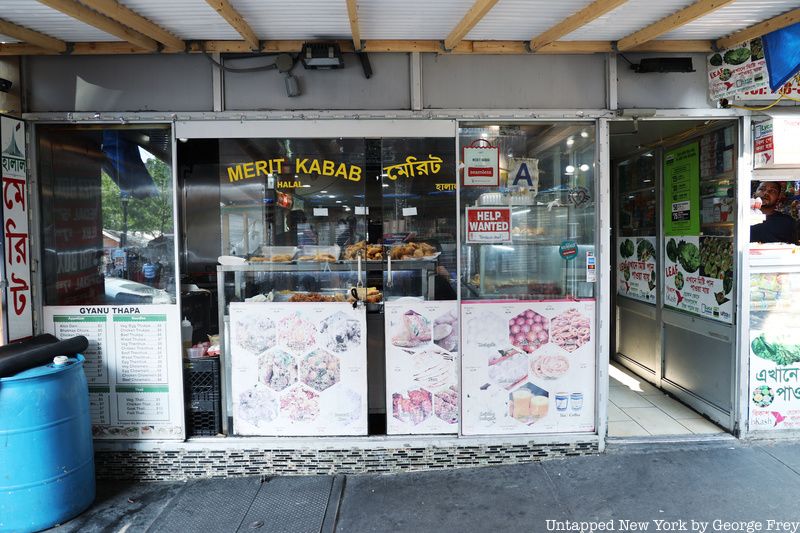
Merit Kabab Palace offers affordable Indian, Bangladeshi, and Nepalese dishes just seconds from the 7 train. When walking past this hole-in-the-wall joint, many diners are drawn in by Indian sweets sold by the pound and piles of samosas seen through the window.
At the front of the eatery are various display cases holding Indian and Bangladeshi specialties such as curries and biryanis. Nepalese specialties like momos and chow mein are found in the back. At Merit Kabab, the naan is perfect to dip in curry and the samosas are sold for $1.50 each. Customers pile into the space, leaving all to enjoy dishes like chicken biriyani and goat curry in tight quarters.
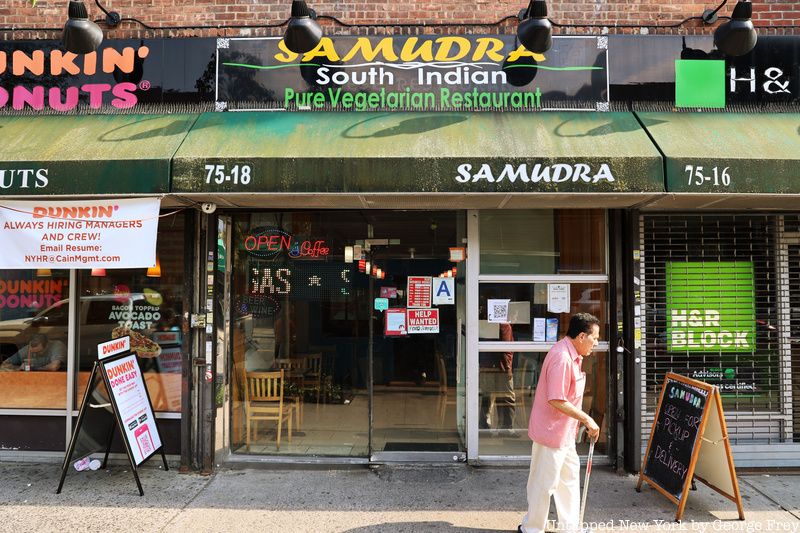
Sandwiched between a Dunkin’ Donuts and an H&R Block, Samudra is easy to overlook. However, this palace of vegetarian Indian food should not be missed. The “pure vegetarian” experience that will ensue will certainly contain mountains of cheese, vegetables, potatoes, and pillowy naan.
When visiting the eatery, it is vital that one orders a dosa. These thin, South-Asian crepes can be filled with potato masala or enjoyed plain with coconut chutney and sambar, a lentil-based vegetable stew. At Samudra, it is not hard to enjoy aloo gobi and paneer uthappam, a South Indian pancake with cottage cheese and mild spices. The welcoming staff and atmosphere filled with Indian music and notes of curry powder make the restaurant a popular gathering spot for families and friends.

John Eberson, an acclaimed theater architect, constructed the Earle Theater in the 1930s. This Art Deco cinema showed legitimate films like The Lives of a Bengal Lancer for decades but transitioned to show adult films in the 1970s. As the theater became the Eagle Theater that showed Bollywood films, the Indian community in Jackson Heights increased. A South Asian food court took over the space after the theater closed due to an Indian actors’ strike.
To this day, Ittadi Garden & Grill serves specialties such as samosas and momos in this Art Deco building. Located in Diversity Plaza, Ittadi Garden & Grill shows the full transition Jackson Heights has made from a quiet neighborhood of gardens and Art Deco decor to one of cultural collaboration and celebration. Affordable prices and a frequently shifting menu leave few excuses not to try everything that suits your fancy.
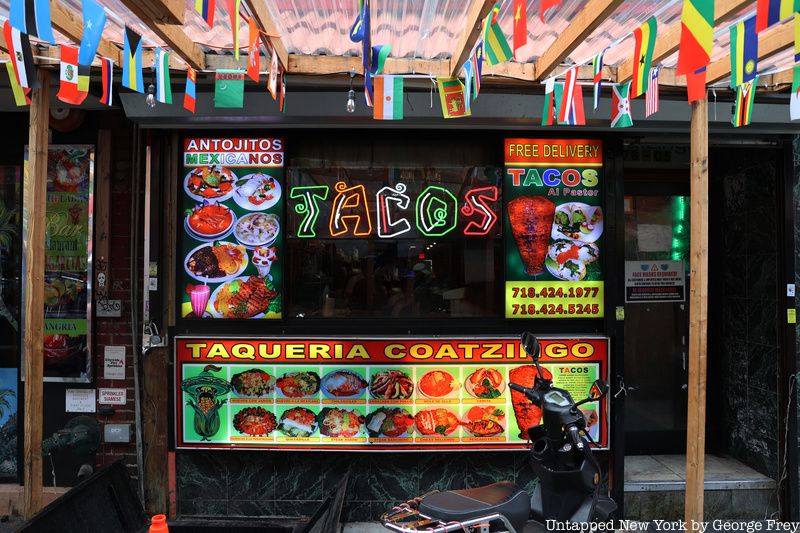
Known for packed tacos and a seemingly endless menu, Taqueria Coatzingo is one of the best spots for Mexican food in Jackson Heights. This joint opens at 10 a.m. just in time for breakfast. Eggs can be enjoyed with salsa verde, cactus, and ham. Entrees include tortas, quesadillas, and burritos, along with an extensive list of platillos — dishes including birria de res and carnitas en salsa verde.
However, the party starts with the tacos that Taqueria Coatzingo serves until 1 a.m. The carne asada and carnitas tacos are best enjoyed with rice and beans. Lengua al Vapor tacos, or steamed tongue tacos, always contain guacamole, cilantro, and onions. For dessert, divulge in a slice of flan or tres leches cake.
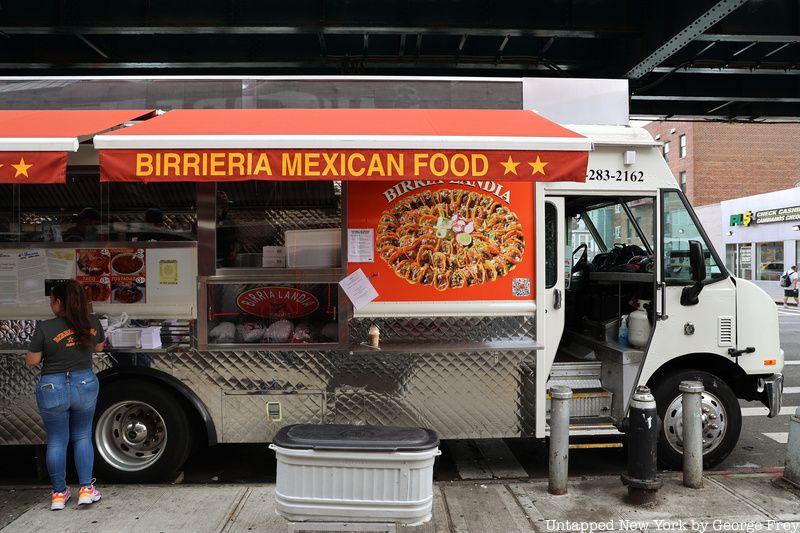
After Birria — a Mexican beef stew from the state of Jalisco — swept across Los Angeles over the past few years, many New York City chefs adopted this trendy dish as well. Another New York Times Critic’s Pick, food truck Birria-Landia is often called “Beefrria-Landia” because of a blue light sign on the side of the truck. The truck opens around 5 p.m. on weekdays and around 1 p.m. on weekends and closes after midnight.
Lines often curve well around the block with customers eager to consume at least one of the four dishes on the menu: birria tacos, birria tostadas, birria mulita cheese quesadilla, and birria consommé. These menu items are typically bought in pairs, however, to follow Jalisco locals who take a sip of consommé broth after taking a bite of their birria taco. Following birria’s rise in popularity on social media, many now dip birria tacos in the consommé as well. Other New York City birria spots include Las Delicias Mexicanas in East Harlem and El Gallo Taqueria in Brooklyn.

Arepas, flat pancakes made of ground kernels of maize meal, are a specialty of Colombia and Venezuela. These maize patties can be served either as a sandwich or as bread to be dipped in a sauce. At Arepa Lady, a Colombian restaurant across the street from P.S. 69, arepas are sold in four varieties: choclo, queso, rellena, and tela. Whereas arepas de tela are gluten-free, arepas de choclo are made with sweet corn, arepas de queso are made with cheese, and arepas de rellena are stuffed arepas that originated in Venezuela.
The arepas are so large they can often be shared between two diners. Small plates include mini empanadas and charred street corn. In addition to arepas, Arepa Lady serves an array of patacones — fried plantains that can be topped with chicharron, chorizo, and carne asada. The sauces — creamy and pastel-colored — provide extra flavor to already delicious dishes.
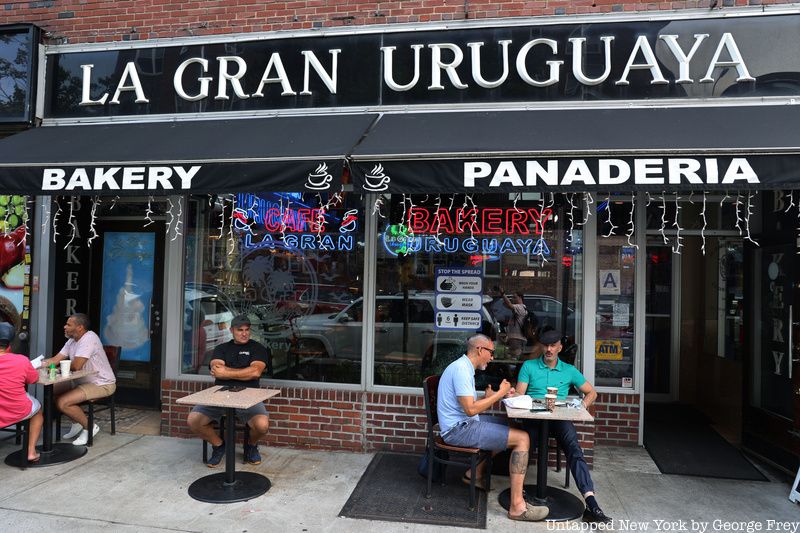
La Gran Uruguaya Bakery sits in New York City, however, its pastries and impressive collection of baseball caps denoting different soccer teams argue otherwise. Due to New York’s small, concentrated community of Uruguayan’s in Jackson Heights, one of the best spots for Uruguayan specialties like postre chajá, or Uruguayan meringue, is La Gran Uruguaya Bakery. They also sell pastries from Argentina and Colombia.
Pastries topped with fruit, cream, and chocolate, as well as fresh bread, line the display cases within the bakery. First-time customers can divulge in any pastry containing dulce de leche, a beloved sweet in most Latin American countries. Some of these include a dulce de leche roll and churro filled with dulce de leche. Their alfajores, a dulce de leche sandwich cookie found throughout Uruguay, can (and should) be eaten by the handful. Do not tell the dentist about all this sugar, though.
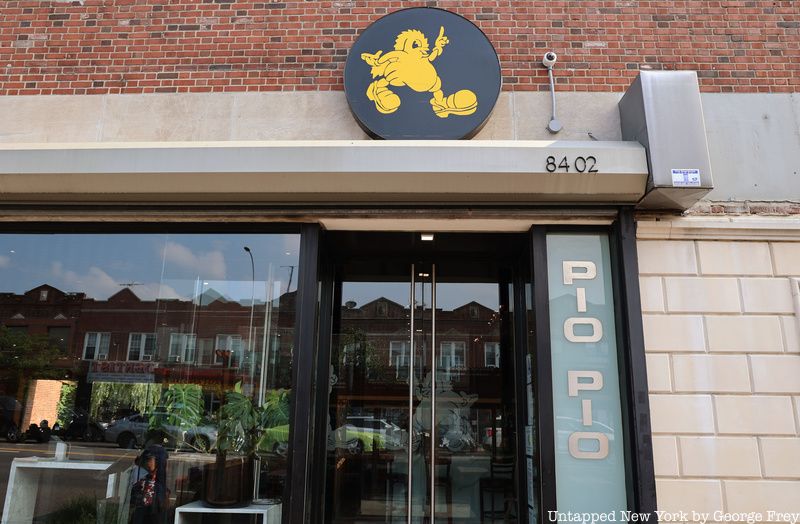
Established in Rego Park in 1994, Pio Pio has since added eight other locations throughout New York City. This family-owned and operated Peruvian restaurant specializes in pollo a la brasa, or rotisserie chicken. Their aji verde sauce — a spicy green sauce typically made of cilantro, jalapeños, mayonnaise, and parmesan — gives a kick to an already juicy, flavorful chicken.
The Matador Combo, one of the most popular items on the menu, is a must-order if dining in a group. For $42, a table can receive a whole rotisserie chicken, yellow rice, red beans, tostones, salchipapas, and avocado salad. When dining at Pio Pio on a Wednesday, be ready to listen to music played live by Grupo Huayno, a Peruvian band that gained popularity for its Subway performances.
Next, check out the top 10 secrets of Jackson Heights!
Subscribe to our newsletter